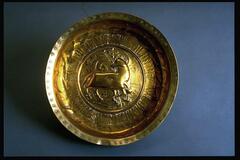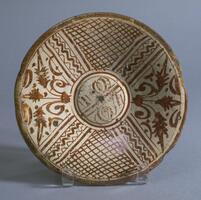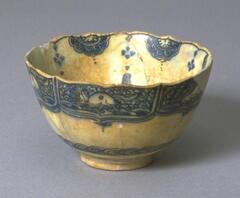84 UMMA Objects
84 UMMA Objects
![This dish features a three part structural division; the boss is almost flat. Around the depressed area is a band of degenerate Gothic [or pseudo-Arabic] script. On the brim are solid lustre painted zig-zags, possibly a late version of gadroons. The empty areas of this pattern are filled with dots and floral motifs. The reverse has repeated circles only. This dish features a three part structural division; the boss is almost flat. Around the depressed area is a band of degenerate Gothic [or pseudo-Arabic] script. On the brim are solid lustre painted zig-zags, possibly a late version of gadroons. The empty areas of this pattern are filled with dots and floral motifs. The reverse has repeated circles only.](/media/W1siZiIsIjIwMjIvMDUvMjUvNHVtdXlvNGgwcF9kZWZhdWx0LmpwZyJdLFsicCIsInRodW1iIiwiMjQweDIwMCJdXQ?sha=4c312278c29b047b)
Moorish (Moorish)
Shallow Dish
16th century
Transfer from the College of Architecture and Design
1972/2.119

Flemish (Flemish (culture or style))
The Rape of Europa
1567 – 1632
Bequest of Margaret Watson Parker
1955/1.186

1567 – 1632
The Paul Leroy Grigaut Memorial Collection
1969/2.92

Chinese (Chinese (culture or style))
Historical Figures in Settings of Different Seasons
1500 – 1699
Gift of Dr. and Mrs. Clyde Wu
1985/1.198.3

Flemish (Flemish (culture or style))
Tapestry;Border Fragment (Central cartouche depicting 'Atlanta and the Caledonia
1567 – 1632
Gift of Colonel and Mrs. Thomas M. Spaulding
1967/2.14

Alessandro Allori (Italian (culture or style))
Ferdinand I de'Medici
1500 – 1699
Bequest of Henry C. Lewis
1895.68
![Burial wares are those placed in tombs as a way of praying for the continued happiness and comfort of the deceased in the afterlife. Offering vessels produced in the Joseon period included smaller reproductions of the vessels used every day, such as jars, boxes, and bowls, among others. The University of Michigan Museum of Art houses a set of white porcelain offering vessels buried in pit graves between the late 16th century and early 17th century. The vessels are coated in pale blue glaze but generally tinged with gray. They were fired without using saggers, while resting on fine sand supports. Their glaze is relatively well applied and fused. The cintamani-shaped knobs on the lids are similar to those found on the lids of vessels produced at white porcelain kilns near Seondong-ri and Songjeong-ri in Gwangju-si, Gyeonggi-do in the 17th century.<br />
[Korean Collection, University of Michigan Museum of Art (2014) p.188] Burial wares are those placed in tombs as a way of praying for the continued happiness and comfort of the deceased in the afterlife. Offering vessels produced in the Joseon period included smaller reproductions of the vessels used every day, such as jars, boxes, and bowls, among others. The University of Michigan Museum of Art houses a set of white porcelain offering vessels buried in pit graves between the late 16th century and early 17th century. The vessels are coated in pale blue glaze but generally tinged with gray. They were fired without using saggers, while resting on fine sand supports. Their glaze is relatively well applied and fused. The cintamani-shaped knobs on the lids are similar to those found on the lids of vessels produced at white porcelain kilns near Seondong-ri and Songjeong-ri in Gwangju-si, Gyeonggi-do in the 17th century.<br />
[Korean Collection, University of Michigan Museum of Art (2014) p.188]](/media/W1siZiIsIjIwMjIvMDkvMjQvMmFsZnFybWRwaF9kZWZhdWx0LmpwZyJdLFsicCIsInRodW1iIiwiMjQweDIwMCJdXQ?sha=19cfe56e758baf7a)
Korean (Korean (culture or style))
Burial Set (15 plates, 16 bowls and 6 lids)
17th century
Gift of Ok Ja Chang and the Chang Family
2009/2.79.7
![Burial wares are those placed in tombs as a way of praying for the continued happiness and comfort of the deceased in the afterlife. Offering vessels produced in the Joseon period included smaller reproductions of the vessels used every day, such as jars, boxes, and bowls, among others. The University of Michigan Museum of Art houses a set of white porcelain offering vessels buried in pit graves between the late 16th century and early 17th century. The vessels are coated in pale blue glaze but generally tinged with gray. They were fired without using saggers, while resting on fine sand supports. Their glaze is relatively well applied and fused. The cintamani-shaped knobs on the lids are similar to those found on the lids of vessels produced at white porcelain kilns near Seondong-ri and Songjeong-ri in Gwangju-si, Gyeonggi-do in the 17th century.<br />
[Korean Collection, University of Michigan Museum of Art (2014) p.188] Burial wares are those placed in tombs as a way of praying for the continued happiness and comfort of the deceased in the afterlife. Offering vessels produced in the Joseon period included smaller reproductions of the vessels used every day, such as jars, boxes, and bowls, among others. The University of Michigan Museum of Art houses a set of white porcelain offering vessels buried in pit graves between the late 16th century and early 17th century. The vessels are coated in pale blue glaze but generally tinged with gray. They were fired without using saggers, while resting on fine sand supports. Their glaze is relatively well applied and fused. The cintamani-shaped knobs on the lids are similar to those found on the lids of vessels produced at white porcelain kilns near Seondong-ri and Songjeong-ri in Gwangju-si, Gyeonggi-do in the 17th century.<br />
[Korean Collection, University of Michigan Museum of Art (2014) p.188]](/media/W1siZiIsIjIwMjIvMDkvMjQvOWlpdDg4YXNlcF9kZWZhdWx0LmpwZyJdLFsicCIsInRodW1iIiwiMjQweDIwMCJdXQ?sha=16d2250d13230546)
Korean (Korean (culture or style))
Burial Set (15 plates, 16 bowls and 6 lids)
17th century
Gift of Ok Ja Chang and the Chang Family
2009/2.79.9
![Burial wares are those placed in tombs as a way of praying for the continued happiness and comfort of the deceased in the afterlife. Offering vessels produced in the Joseon period included smaller reproductions of the vessels used every day, such as jars, boxes, and bowls, among others. The University of Michigan Museum of Art houses a set of white porcelain offering vessels buried in pit graves between the late 16th century and early 17th century. The vessels are coated in pale blue glaze but generally tinged with gray. They were fired without using saggers, while resting on fine sand supports. Their glaze is relatively well applied and fused. The cintamani-shaped knobs on the lids are similar to those found on the lids of vessels produced at white porcelain kilns near Seondong-ri and Songjeong-ri in Gwangju-si, Gyeonggi-do in the 17th century.<br />
[Korean Collection, University of Michigan Museum of Art (2014) p.188] Burial wares are those placed in tombs as a way of praying for the continued happiness and comfort of the deceased in the afterlife. Offering vessels produced in the Joseon period included smaller reproductions of the vessels used every day, such as jars, boxes, and bowls, among others. The University of Michigan Museum of Art houses a set of white porcelain offering vessels buried in pit graves between the late 16th century and early 17th century. The vessels are coated in pale blue glaze but generally tinged with gray. They were fired without using saggers, while resting on fine sand supports. Their glaze is relatively well applied and fused. The cintamani-shaped knobs on the lids are similar to those found on the lids of vessels produced at white porcelain kilns near Seondong-ri and Songjeong-ri in Gwangju-si, Gyeonggi-do in the 17th century.<br />
[Korean Collection, University of Michigan Museum of Art (2014) p.188]](/media/W1siZiIsIjIwMjIvMDkvMjQvMzhxM2dveGoxeV9kZWZhdWx0LmpwZyJdLFsicCIsInRodW1iIiwiMjQweDIwMCJdXQ?sha=9c9b42b61d748008)
Korean (Korean (culture or style))
Burial Set (15 plates, 16 bowls and 6 lids)
17th century
Gift of Ok Ja Chang and the Chang Family
2009/2.79.11
![Burial wares are those placed in tombs as a way of praying for the continued happiness and comfort of the deceased in the afterlife. Offering vessels produced in the Joseon period included smaller reproductions of the vessels used every day, such as jars, boxes, and bowls, among others. The University of Michigan Museum of Art houses a set of white porcelain offering vessels buried in pit graves between the late 16th century and early 17th century. The vessels are coated in pale blue glaze but generally tinged with gray. They were fired without using saggers, while resting on fine sand supports. Their glaze is relatively well applied and fused. The cintamani-shaped knobs on the lids are similar to those found on the lids of vessels produced at white porcelain kilns near Seondong-ri and Songjeong-ri in Gwangju-si, Gyeonggi-do in the 17th century.<br />
[Korean Collection, University of Michigan Museum of Art (2014) p.187] Burial wares are those placed in tombs as a way of praying for the continued happiness and comfort of the deceased in the afterlife. Offering vessels produced in the Joseon period included smaller reproductions of the vessels used every day, such as jars, boxes, and bowls, among others. The University of Michigan Museum of Art houses a set of white porcelain offering vessels buried in pit graves between the late 16th century and early 17th century. The vessels are coated in pale blue glaze but generally tinged with gray. They were fired without using saggers, while resting on fine sand supports. Their glaze is relatively well applied and fused. The cintamani-shaped knobs on the lids are similar to those found on the lids of vessels produced at white porcelain kilns near Seondong-ri and Songjeong-ri in Gwangju-si, Gyeonggi-do in the 17th century.<br />
[Korean Collection, University of Michigan Museum of Art (2014) p.187]](/media/W1siZiIsIjIwMjIvMDkvMjQvNWwycmNnaGJ6MF9kZWZhdWx0LmpwZyJdLFsicCIsInRodW1iIiwiMjQweDIwMCJdXQ?sha=18520f4db3e3bc00)
Korean (Korean (culture or style))
Burial Set (15 plates, 16 bowls and 6 lids)
17th century
Gift of Ok Ja Chang and the Chang Family
2009/2.79.12
Loading…


